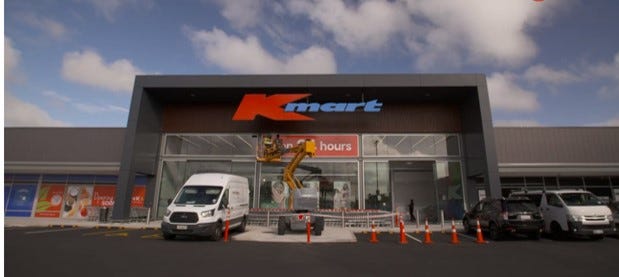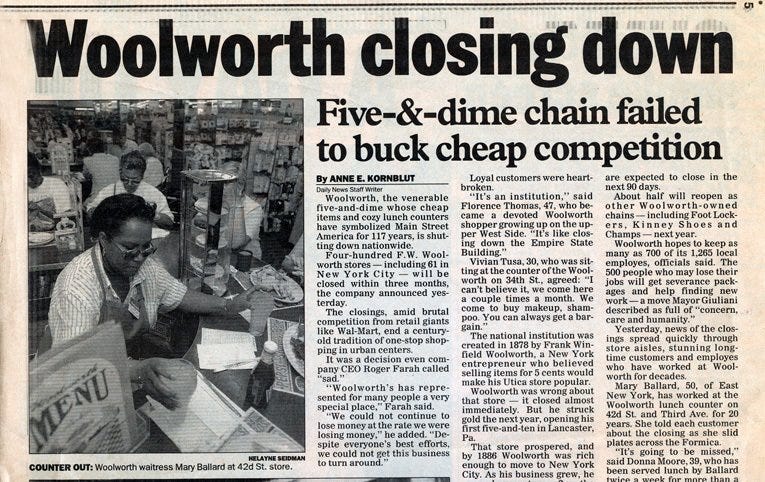Toys R Us Australia Is Bankrupt (Again) — But Other Defunct U.S. Retail Brands Like Kmart and Woolworths Are Thriving In The Land Down Under
In the 1960s Kmart and F.W. Woolworth were two of the most prominent U.S. retailers; over 60 years later the two brands barely exist in the U.S. but are two of the largest retailers in Australia
Last week Toys R Us Australia entered “administration”—or Australia’s equivalent of bankruptcy protection—for a second time.
But while Toys R Us has struggled in Australia, other once-iconic U.S. retail brands continue to thrive in the land down under.
For instance two of Australia’s largest retailers in 2025 are none other than well-known U.S. retail brands of yesteryear: Kmart and Woolworths.
In the mid-1960s Kmart and Woolworth stores dominated U.S. retail.
But today there is just a single Kmart store left in the U.S.—and the last F.W. Woolworth store in the U.S. closed in 1997.
In Australia, though, Kmart and Woolworths are big players.
Kmart currently operates over 300 stores in Australia and ~80% of Australians live within 10 kilometers (~6 miles) of a Kmart store.
Woolworths, meanwhile, operates over 1,000 supermarkets and is the 3rd largest company by revenue in Australia.
So what connection—if any—do Kmart and Woolworths in Australia have with their one-time U.S. counterparts?
In 1965 the S.S. Kresge Company was one of the largest domestic retailers and operated over 900 stores in the U.S.
Just three years prior it had launched the Kmart concept in an ~80,000 square foot discount store format that S.S. Kresge would ultimately grow to over 2,000 locations.
Similarly, in 1965 the F.W. Woolworth Company operated ~600 of its classic “five and dime” stores that sold merchandise at a low fixed price.
The first Woolworth store had opened way back in 1879; by the early 1900s the Company operated over 1,000 stores in the U.S., Canada and Europe.
At the same time that Kmart and F.W. Woolworth were dominating U.S. retail, a pair of similarly named companies were also expanding in Australia.
Kmart was introduced to Australia in the late 1960s as a joint venture between the U.S. company and the Coles Group, an Australian retailer.
But the U.S. Kmart chain divested its remaining stake in the Australian joint venture in 1994 and has no ties to the current business.
The Australian Woolworths is also no upstart — it marked its 100th year of operation in 2024.
But unlike Kmart Australia, Woolworths in Australia never had any ties to F.W. Woolworth Company in the U.S.
The Australian chain’s founders had chosen the Woolworths name to capitalize on the well-known U.S. company as F.W. Woolworth had not registered or trademarked its brand in Australia.
But while the F.W. Woolworth and Kmart businesses faltered in the U.S. in recent decades, Kmart and Woolworths now dominate the retail landscape in Australia.
More than 100 of Kmart's 325 stores in Australia and New Zealand opened during the past ten years.
Including Kmart’s flagship, multi-story site in the central business district of Melbourne that, at 5,000 square meters (~50,000 square feet), is also its largest store.
Kmart has so many locations in Australia that over 80% of Australians live within 10 kilometers (~6 miles) of a Kmart store.
Similarly, while Woolworths has operated a variety of retail formats and engaged in real estate development and other business lines over its 100 year history, the Company has focused on its retail supermarket operations for the past 15 years.
Woolworths has also undertaken several unique adaptive reuse projects to develop new stores.
Like the repurpose of a 12,500 square meter (~135,000 square foot) shuttered Bunnings Home Improvement warehouse in the Sydney suburb of North Parramatta.
It is now anchored by a ~3,800 square meter (~40,000 square foot) Woolworths supermarket as well as a liquor store, gym, specialty shops and an outdoor dining area.
Woolworths is also planning to repurpose yet another former Bunnings Warehouse in the southwest suburbs of Newcastle, Australia.
This ~13,000 square meter (~140,000 square foot) former Bunnings Warehouse is set to be transformed into a full-line Woolworths supermarket all within the four walls of the existing building.
As for the Kmart and F.W. Woolworth operations in the U.S.?
Well a single Kmart store still operates in the Miami area.
But the rest of its 2,000+ U.S. stores have now closed (though much of the Kmart real estate has been repurposed or redeveloped).
And F.W. Woolworth?
Well the "five-and-dime" stores that it popularized in the early 20th century have long since closed.
But F.W. Woolworth had diversified into other retail segments in the late 1960s and early 1970s.
In fact F.W. Woolworth the company still exists today—though not likely for much longer.
It even operates ~2,500 retail stores in more than 25 countries.
F.W. Woolworth changed its name in 2001 to go by the brand name in which it operates these retail sites:
Foot Locker FL 0.00%↑.
But the pending acquisition of Foot Locker by Dick’s Sporting Goods DKS 0.00%↑ will likely mark the end of it as a publicly listed company.
More than 113 years after corporate predecessor F.W. Woolworth’s initial public offering on the New York Stock Exchange back in 1912.










